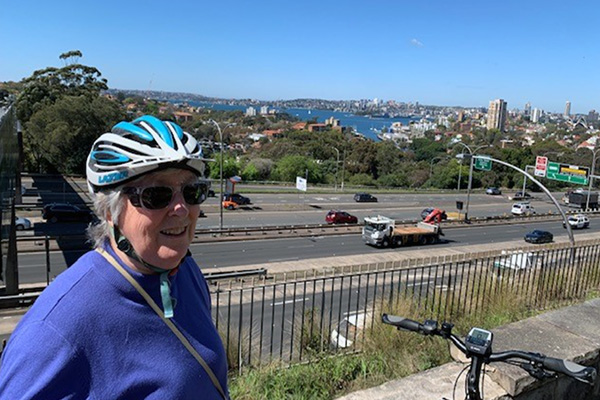The short answer is we still don’t know, and that has us worried.
Given the Warringah Freeway Upgrade (WFU) is a $1.18 billion project, and preliminary construction is underway, one would assume that there are excellent plans to leverage the investment to deliver amazing new facilities for walking and cycling.
Condition E195 of the planning approval states that an Active Transport Network Review must be prepared in consultation with relevant Councils, Bicycle NSW and Bike North. Bicycle NSW and Bike North have been attending consultation meetings over many years, but we have still not seen the draft review, or tangible plans for the future network.
The engagement process has instead centred on advising detours to existing bicycle infrastructure already affected by construction. This is useful information, but not genuine consultation.

Bicycle NSW recently toured the areas of concern and sites of opportunity along the Warringah Freeway corridor with Bike North and staff from North Sydney Council. Carolyn New from Bike North (left) looks down over the hugely wide motorway. Phillip Hart of Bike North with Francis O’Neill and Sarah Bickford from Bicycle NSW (right). (Source: Bicycle NSW / Bike North)
The longer Transport for NSW (TfNSW) withhold active travel plans, the greater the risk that inadequate cycling infrastructure will be delivered. Concrete is being poured now! Reasons for not providing draft plans include (i) active travel plans don’t yet exist; (ii) the plans can’t be revealed until they have been integrated with the planned Eastern Harbour City Strategic Cycleway Corridors; and (iii) the TfNSW bureaucracy is slow. (i) and (ii) are contradictory and (iii) does not square with the visible pace of construction. It also belies the tenor of other projects in which there is strong positive engagement with Bicycle NSW. We value this collaboration and would like to see it at play on the WFU.
The devil is in the detours
The imminent removal of the Falcon Street shared path underpass and the long, inconvenient detour (yellow dotted line in the map below) illustrates the complete lack of priority given to walking and cycling.

The detour proposed by the project team for pedestrians and cyclists after the removal of the shared path underpass. The underpass will be closed from 3rd October (Source: CPBD / TfNSW). At a meeting on 19th September, the team admitted that the proposed arrangements for pedestrians and cyclists are not acceptable. Under Condition E200, a safe and convenient route across Falcon Street must be delivered. We urged the project team to develop and implement a solution before removing the underpass.
Transport for NSW must back its own policies
Unfortunately, the contractors are working to the Conditions of Consent that were formulated in 2017. Over the last 5 years, the political and strategic context has shifted significantly in favour of active transport.
TfNSW is now bound by the Providing for Walking and Cycling in Transport Projects and Road User Space Allocation policies which prioritise active transport over private vehicles. These excellent policies are an important lever to push back against the 70-year-old paradigm of building more roads to reduce traffic congestion.
250,000 vehicles use the Warringah Freeway each day. Creating more space for vehicles is like trying to put out a fire with kerosene. It is unsustainable economically. By 2031 traffic congestion will cost the economy $39.6 billion without a concerted effort to reduce private car use for short daily trips.
Warringah Freeway is 15 lanes wide in places. It is unreasonable to claim there is ‘not enough space for excellent active transport infrastructure. TfNSW must review the Conditions of Consent, pause construction if necessary and develop detailed designs that maximise the future outcomes for walking and cycling.

The extremely narrow and congested Pacific Highway shared path on the regional bike route from the Harbour Bridge to North Sydney (left). A wide strip of vacant land south of Ridge Street that should be considered for active transport (centre). The high-quality shared user Falcon Street underpass (right) is slated for removal to create a bus lane. The underpass could be extended to provide a direct and comfortable link to Alfred Street North and the Ridge Street bridge but it will be gone before proper future-proof plans can be drawn up
(Source: Bicycle NSW)
Bicycle NSW will continue working with Bike North and TfNSW on better outcomes along this key corridor. Please consider supporting our advocacy work on active transport infrastructure, both in North Sydney and across NSW, by joining the Bicycle NSW family today.

